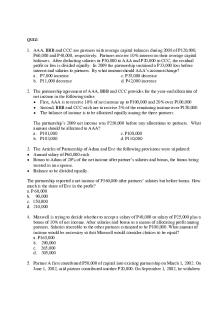11 - Accounting Theories PDF

| Title | 11 - Accounting Theories |
|---|---|
| Author | Dip Per |
| Course | ACCOUNTANCY |
| Institution | Our Lady of Fatima University |
| Pages | 11 |
| File Size | 180.2 KB |
| File Type | |
| Total Downloads | 578 |
| Total Views | 1,021 |
Summary
OPERATING SEGMENTQUESTION 20-15 Multiple choice (PFRS 8)1. Segment reporting shall apply toa. Separate financial statements of an entity only.b. Consolidated financial statements of a group only.c. Both the separate financial statements of an entity and the' consolidated financial statements of a gr...
Description
OPERATING SEGMENT QUESTION 20-15 Multiple choice (PFRS 8) 1. Segment reporting shall apply to a. Separate financial statements of an entity only. b. Consolidated financial statements of a group only. c. Both the separate financial statements of an entity and the' consolidated financial statements of a group d. Neither the separate financial statements of an entity nor the consolidated financial statements of a group. 2. If a financial report contains both the consolidated financial statements of a parent and the parent's separate financial statements, segment information is required in a. The separate financial statements only b. The consolidated financial statements only c. Both the separate statements d. Neither the separate statements 3. An operating segment is a component of an entity a. b. c. d.
That engages in business activities from which it may earn revenue and incur expenses. Whose operating results are regularly reviewed by the entity's chief operating decision maker. For which discrete information is available. All of these characterize an operating segment.
4. Which quantitative threshold is not a requirement in qualifying a reportable segment? a. The segment revenue, both external and internal, is 10% or more of the combined external and internal revenue of all operating segments. b. The segment profit or loss is 10% or more of the greater between the combined profit of profitable segments and combined loss of unprofitable segments. c. The segment assets are 10% or more of the combined assets of all operating segments. d. The segment assets are 20% or more of the combined assets of all operating segments. 5. Which statement is true concerning the 75% overall size test for reportable segments? a. The total external and internal revenue of all reportable segments is 75% or more of the entity's external revenue. b. The total external revenue of all reportable segments is 75% or more of the entity’s external and internal revenue.
c. The total external revenue of all reportable segments is 75% or more of the entity's external revenue. d. The total internal revenue of all reportable segments is 75% or more of the entity’s internal revenue. 6. The term chief operating decision maker a. b. c. d.
Refers to a manager with a specific title. Must be by title in the financial reporting for segments. Must be described in the disclosures for the financial reporting for segments. Refers to a function of allocating resources to the operating segments and assessing their performance.
7. Which statement is not true with respect to a chief operating decision maker? a. The term chief operating decision maker identifies a function and not necessarily a manager with a specific title. b. In some cases, the chief operating decision maker could be the chief operating officer. c. The board of directors acting collectively could qualify as the chief operating decision maker. d. The chief internal auditor would generally qualify as chief operating decision maker. 8. In financial reporting for operating segments, an entity shall disclose all of the following, except a. Type of product and service from which each reportable segment derives revenue. b. The title of the chief operating decision maker. c. Factors used to identify the reportable segments. d. The basis of measurement of segment profit or loss and segment assets. 9. Two or more operating segments may be aggregated into a single operating segment if all of the following conditions are satisfied, except a. The segments have similar characteristics. b.
The segments share a majority of the nature of product or service, nature of production process, class of customer, method of product distribution and regulatory environment. c. The aggregation is consistent with the core principle of segment reporting. d. The segments have dissimilar characteristics. 10. Operating segments that do not meet any of the quantitative thresholds a. Cannot be considered reportable. b. May be considered reportable and separately disclosed if management believes that information about the segment would be useful to the users of the financial statements. c. May be considered reportable and separately disclosed if the information is for internal use. d. May be considered reportable and separately disclosed if this is the practice within the economic environment in which the entity operates.
QUESTION 20-16 Multiple choice (PFRS8) 1. What are the disclosures required in relation to operating segments? a. General information about the operating segment. b. Information about segment profit or loss, including specified revenue and expenses included in profit or loss, segment assets and segment liabilities. c.
d.
Reconciliations of total segment revenue, total segment profit or loss, total segment assets and total segment liabilities to the corresponding amounts in the entity's financial statements. All of these are required be disclosed.
2. An entity shall disclose which of the following general information? a. Factors used to identify the reportable segments b. Types of products and services c. Factors used to identify the reportable segments and types of products and services d. Names of the board of directors 3. Segment reporting requires that an entity should provide reconciliations of segment information. Which is not a required reconciliation? a. The total of the reportable segments' revenue to the entity revenue b. The total of the reportable segments' profit or loss to the entity profit or loss before tax expense and discontinued operations c. The total number of major customers of all segments to the total number of major customers of the entity d. The total of the reportable segments' assets to the entity assets 4. Which of the following is, a required enterprise-wide disclosure regarding external customers? a. The identity of any external customer considered to be major by management b. The identity of any external customer providing 10% or more of a particular operating segment revenue c. Information on major customers is not required in segment reporting
d. The fact that transactions with a particular external customer constitute at least 10% of the total entity revenue. 5. An operating segment is considered reportable when any of the following conditions is met, except a. Segment revenue is 10% or more of the combined revenue of all of the entity's segments. b. Segment assets are 10% or more of the combined assets of all segments. c. Segment liabilities are 10% or more of the combined liabilities of all segments. d. Segment's profit or loss is 10% or more of the combined profit of all segments that did not incur a loss
3.
4.
5.
6.
QUESTION 20-17 Multiple choice (PFRS 8) 1. Entity-wide disclosures include all, except a. Information about products b. Information about geographical areas c. Information about major customers d. Information about intersegment revenue 2. Which statement is true about major customer disclosure? a. A major customer is defined as one providing revenue which amounts to 10% or more of combined external revenue of all operating segments. b. The identities of major customers need not be disclosed. c. The entity shall disclose the total amount of revenue from major customers. d. All of these statements are true about major customer disclosures. Which entity is required to report on business segments? a. Publicly traded b. Not for profit c. Joint venture d. Nonpublic An entity must disclose all of the following about each reportable segment if the amounts are used by the chief operating decision maker, except a. Depreciation expense b. Allocated expense c. Interest expense d. Income tax expense An entity shall disclose for each reportable segment all of the following specified amounts included in the measure of profit or loss, except a. Revenue from external customers b. Revenue from internal customers c. Interest revenue d. Gain on disposal of investment An entity shall disclose for each reportable segment all of the following specified amounts included in the measure of profit or loss, except a. Depreciation and amortization b. The entity's interest in the profit or loss of associate. c. Income tax expense
d. General corporate expenses 7. An entity must disclose all of the following about each reportable segment if the amounts are used by the chief operating decision maker, except a. Unusual items b. Income tax expense c. Intersegment revenue d. Cost of goods sold 8. For segment reporting purposes, which test must be applied to determine if a component is a reportable operating segment? a. Revenue test and asset test b. Revenue test, asset test and profit or loss test c. Revenue test, asset test and expense test d. Revenue test, asset test and cash flow test 9. What is the practical limit to the number of reportable operating segments? a. Five segments b. Ten segments c. Six segments d. Four segments 10. The approach used in segment reporting is known as a. Segment approach b. Revenue approach c. Management approach d. Enterprise approach...
Similar Free PDFs
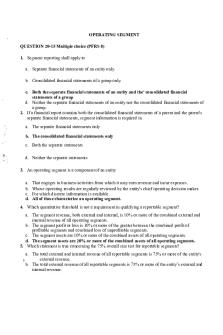
11 - Accounting Theories
- 11 Pages
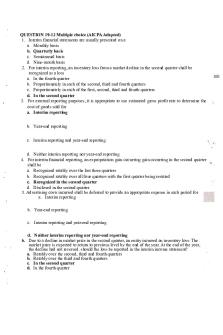
4 - Accounting Theories
- 4 Pages

Chapter 11 - Conflict Theories
- 1 Pages
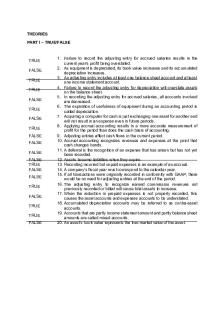
Theories on Accounting
- 4 Pages
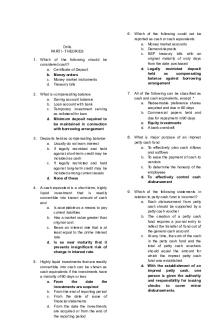
Accounting Theories with Answers
- 3 Pages
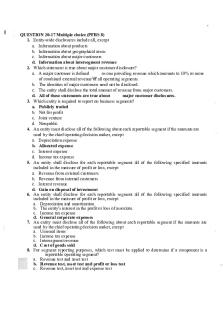
14 - Accounting Theories
- 3 Pages
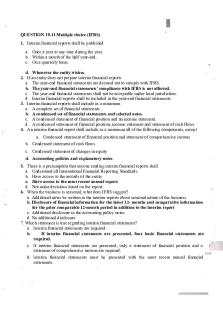
2 - Accounting Theories
- 4 Pages

Theories chapter 11-16
- 18 Pages

Accounting Grade 11 Notes
- 10 Pages

Accounting Grade 11 Notes
- 44 Pages
Popular Institutions
- Tinajero National High School - Annex
- Politeknik Caltex Riau
- Yokohama City University
- SGT University
- University of Al-Qadisiyah
- Divine Word College of Vigan
- Techniek College Rotterdam
- Universidade de Santiago
- Universiti Teknologi MARA Cawangan Johor Kampus Pasir Gudang
- Poltekkes Kemenkes Yogyakarta
- Baguio City National High School
- Colegio san marcos
- preparatoria uno
- Centro de Bachillerato Tecnológico Industrial y de Servicios No. 107
- Dalian Maritime University
- Quang Trung Secondary School
- Colegio Tecnológico en Informática
- Corporación Regional de Educación Superior
- Grupo CEDVA
- Dar Al Uloom University
- Centro de Estudios Preuniversitarios de la Universidad Nacional de Ingeniería
- 上智大学
- Aakash International School, Nuna Majara
- San Felipe Neri Catholic School
- Kang Chiao International School - New Taipei City
- Misamis Occidental National High School
- Institución Educativa Escuela Normal Juan Ladrilleros
- Kolehiyo ng Pantukan
- Batanes State College
- Instituto Continental
- Sekolah Menengah Kejuruan Kesehatan Kaltara (Tarakan)
- Colegio de La Inmaculada Concepcion - Cebu


